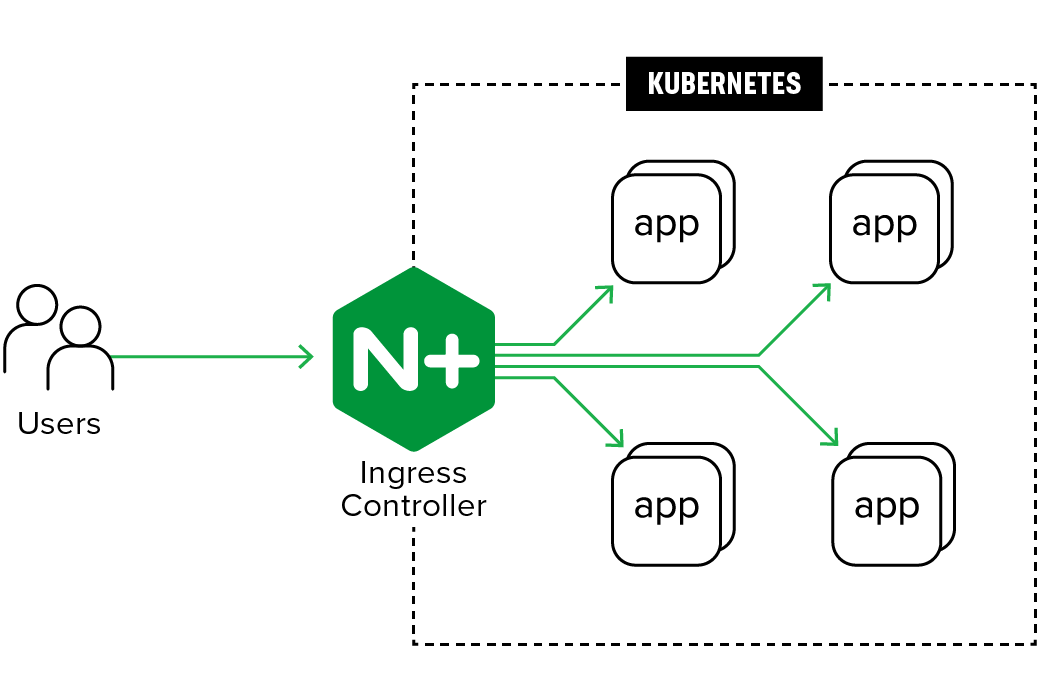コンテナネイティブアプリサービスでアプリケーション配信の遅延を解消
コンテナ化されたアプリケーションのライフサイクルは動的かつ一時的であり、従来のネットワークおよびセキュリティ ポリシーとはうまく調和しない特性があります。 F5 NGINX には解決策があります。
コンテナを活用することで、「一度作成すればどこでも実行できる」という手法でクラウドネイティブ アプリを開発できます。 しかし、それは真空中で起こるわけではありません。 コンテナ化されたアプリケーションでは、最適なパフォーマンスを実現するためにネイティブのアプリケーション配信メカニズムが必要です。 従来の静的な IT 管理構成に固執することは、分単位で発生する可能性のあるマイクロサービス コンテナの起動と停止に対応するために必要な俊敏性と相反します。
マイクロサービス ベースのソリューションを採用する場合は、その動的アーキテクチャに適合したアプリのセキュリティとパフォーマンスのソリューションが必要です。 アプリ サービスをコードとして管理し、CI/CD ワークフローに統合できる必要があります。 コンテナ プラットフォーム管理プレーンと統合された信頼性の高いアプリケーション配信サービスが必要です。
F5 NGINX アプリケーション配信サービスは、コンテナ環境向けに設計および最適化されているため、Kubernetes や Red Hat OpenShift などのコンテナ プラットフォームを活用する場合に最適です。 さらに、コンテナ環境と非コンテナ環境の両方で NGINX を標準化することで、複雑さが軽減され、一貫性と信頼性が向上します。
Kubernetes1 のトップ イングレス コントローラーである NGINX Ingress Controller は、NGINX ロード バランサーの自動構成を提供し、Kubernetes クラスター内のアプリケーションがパフォーマンスを損なうことなく確実かつ安全に配信されることを保証します。
Kubernetes1 のトップ イングレス コントローラーである NGINX Ingress Controller は、NGINX ロード バランサーの自動構成を提供し、Kubernetes クラスター内のアプリケーションがパフォーマンスを損なうことなく確実かつ安全に配信されることを保証します。
チャレンジ
組織は、Kubernetes や RedHat OpenShift などのコンテナ プラットフォームをアジャイル開発手法と組み合わせて使用し、アプリケーションの開発と展開を高速化します。
コンテナは、開発者が「一度記述すればどこでも実行できる」柔軟性と移植性を実現する、クラウドネイティブ アプリケーションを開発するための基本的なインフラストラクチャ コンポーネントです。 コンテナは依存関係を減らし、コンポーネント レベルのスケーリングを可能にします。これは、マイクロサービスを使用してアプリケーションを最新化するための鍵となります。
コンテナ化されたアプリでは、最適なパフォーマンスを実現するためにネイティブ アプリケーション配信メカニズムが必要です。 開発者と DevOps チームには、Kubernetes および OpenShift 環境向けのクラウドに依存しない軽量アプリケーション配信ソリューションが必要です。
しかし、IT 部門によってのみ変更される静的構成の従来のアプローチは、需要の急増に対応するために数分間だけ新しいマイクロサービス コンテナーを動的に作成したり、古いコンテナーを新しいコンテナーに置き換えるだけでアップグレードを展開したりするアジャイル コンテナー パラダイムと矛盾します。
コンテナ化された環境で、アプリ サービスのデプロイメントが迅速なリリース サイクルに対応していることをどのように確認しますか? すべての詳細を確認するには、ソリューション ガイドをダウンロードしてください。
解決
コンテナ プラットフォーム管理プレーンと統合された信頼性の高いアプリケーション配信サービスが必要です。 10 億回以上ダウンロードされ、DockerHub で最も広く利用され、スターを獲得しているアプリケーションである NGINX を使用すると、コンテナ化されたアプリを最適にサポートできます。
また、 Cloud Native Computing Foundationによると、NGINX は市場の 64% を占めており、圧倒的に最も人気のある Kubernetes Ingress コントローラーでもあります。 NGINX は、Kubernetes 上に構築されたコンテナ アプリケーション プラットフォームである Red Hat OpenShift 環境もサポートしています。
コンポーネント
コンテナ化された環境で一貫性のある強力なマルチクラウド アプリケーション サービスを提供するには、次の NGINX コンポーネントを活用します。
- Kubernetes 向け NGINX Ingress コントローラー
DevOps は、Kubernetes 用の NGINX Ingress Controller を使用して、Kubernetes 環境への外部アクセスを提供できます。 これにより、リアルタイム メトリック、セッション永続性、アクティブ ヘルス チェック、JWT 検証など、Kubernetes アプリケーション向けのエンタープライズ グレードの配信サービスが提供されます。
NGINX Plus バージョンでは、ユーザーは中断のない再構成を実行することも可能になり、一貫したアプリケーション パフォーマンスとリソース使用が保証されます。 サポート可能な生産基準に従って構築および維持されており、一貫性と安定性を実現し、下位互換性を維持します。
- OpenShift 向け NGINX Plus ルーター
OpenShift 環境の場合、NGINX は Open Shift Router リソースによって定義された機能を完全にサポートします。
ルーターは、 OpenShift 上で実行されているアプリケーションに送信されるすべての外部リクエストのエントリ ポイントとして機能するため、プラットフォームの最も重要な部分の 1 つになります。 NGINX ルーターは、デフォルトのルーター実装の基盤となるソフトウェアと同じテンプレート ルーター ソフトウェアを通じて OpenShift に統合されています。
結論
アプリケーションは、どこで実行されても、NGINX が提供するパフォーマンスの恩恵を受けることができます。
Kubernetes および OpenShift 環境向けに設計されたソリューションを使用すると、動的コンテナ プラットフォームで実行されるアプリケーションは、コンテナ管理システムのネイティブ ツールを使用して、必要なサービスをオンデマンドで構成できます。
NGINX アプリケーション プラットフォームの将来と、デジタル時代に合わせて企業がアプリケーションを進化させるのを F5 がどのように支援しているかについて詳しくご覧ください。
